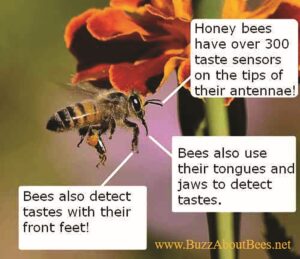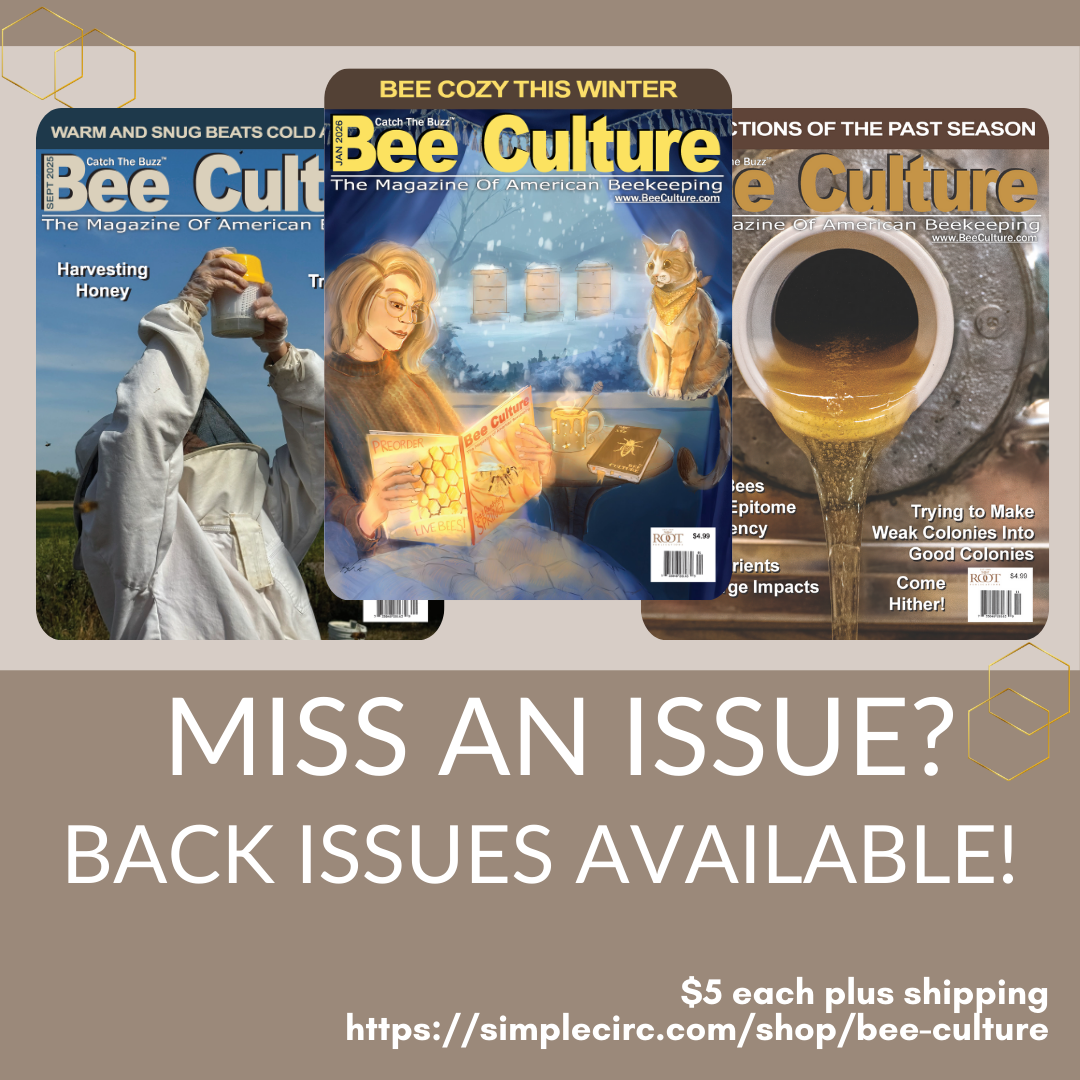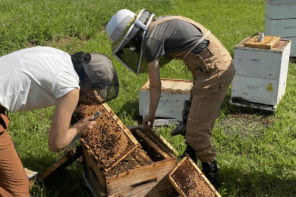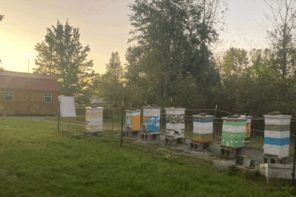Taste Perception
Honey Bee Chemosensory Organs
Clarence Collison
“Taste is crucial for honey bees for choosing profitable food sources, resins, water sources, and for nestmate recognition. Peripheral taste detection occurs within cuticular hairs, the chaotic and basiconic sensilla, which host gustatory receptor cells and, usually a mechanoreceptor cell. Gustatory sensilla are mostly located on the distal segment of the antennae, on the mouthparts, and on the tarsi of the forelegs. These sensilla respond with varying sensitivity to sugars, salts, and possibly amino acids, proteins and water. So far, no responses of receptor cells to bitter substances were found although inhibitory effects of these substances on sucrose receptor cells could be recorded. When bees are free to express avoidance behaviors, they reject highly concentrated bitter and saline solutions. However, such avoidance disappears when bees are immobilized in the laboratory. In this case, they ingest these solutions, even if they suffer afterward a malaise-like state or even die from such ingestion. Central processing of taste occurs mainly in the subesophageal ganglion, but the nature of this processing remains unknown (De Brito Sanchez 2011).”
“In the honey bee, the antennae, mouthparts and tarsi of the forelegs constitute the main chemosensory organs (Goodman 2003). They include gustatory but also hygro, thermo, mechanosensory and olfactory receptors. Gustatory receptor cells on these structures are located within specialized cuticular structures called sensillae, which often take the form of hairs (chaotic sensillae) or pegs (basiconic sensillae) (Esslen and Kaisslin 1976). These sensillae have a characteristic aperture at the apex through which gustatory substances can penetrate after contacting the hair or peg (contrarily to olfactory sensillae whose walls are covered by tiny pores which allow the diffusion of olfactory molecules). Gustatory receptor cells innervate each sensilla and bathe in a receptor hemolymph. Each neuron projects a dendritic branch up the shaft of the hair or peg to the apex. Such a branch – and there may be three to five per sensilla, corresponding to three to five gustatory receptor neurons – bears the molecular receptors to which a gustatory substance will bind if it is the appropriate molecule for these receptors. Such receptors are G-protein coupled proteins. In some cases, a mechanoreceptor cell terminating at the base of the shaft can also be found. This neuron is stimulated not by gustatory stimuli but by movement of the sensilla. As gustatory organs have to explore and manipulate food, evaluating the position and density of the food is facilitated by the presence of mechanoreceptor cells associated with gustatory receptor cells within the same sensilla. Gustatory molecules arrive to the molecular receptors on the membrane of the gustatory neuron through passive diffusion in the hemolymph of the sensilla, or through active transport by carrier proteins. When a gustatory molecule binds to a molecular receptor, the receptor cell depolarizes and, if the magnitude of the receptor potential is enough, an action potential is generated. The gustatory message is then relayed to the central nervous system where it is processed in the subesophageal ganglion (De Brito Sanchez et al. 2007).”
“Taste sensillae can be found essentially on the antennae, mouthparts and legs of a honey bee (Whitehead and Larsen 1976a). On the antennae, gustatory sensillae can be localized on the segment that constitute the flagellum and on the tip. On the mouthparts, they can be localized on the proboscis (formed by the maxillae and the labium), the glossa, the labial palps and the galeae of the maxilla. On the legs, they have been reported on the tarsus and pretarsus of the forelegs. The tarsi of the mid- and hindlegs also bear taste sensillae but these have been poorly characterized (Frings and Frings 1949). So far, research on gustatory function in bees has focused on these body appendages. However, gustatory receptors could be situated in unsuspected parts of the body. For instance, such receptors could be found in the oral cavity and in the crop. Such internal receptors could act as molecule counters allowing the estimation of the intake rate of gustatory stimuli such as sucrose. In this case, they would allow a concrete estimation of food source profitability. Gustatory sensillae play an important role in appetitive food sensing as shown by the fact that stimulation of antennae, tarsi and mouth parts with sucrose solution elicits the so-called proboscis extension reflex (PER) (Takeda 1961; Bitterman et al. 1983). Gustatory sweet receptors on the antennae are more sensitive than those of the legs as shown by the fact that bees extend the proboscis to sucrose solution at a threshold concentration of 2.85% if applied to the antennae, and of 34.23% if applied to the tarsi (Marshall 1935). At the central level, a unique neuron, VUMmx1 (initials of Ventral Unpaired Median maxillar1 neuron) whose cell body can be found in the maxillary neuromere of the subesophageal ganglion (De Brito Sanchez et al. 2007).”

“Taste plays a crucial role in the life of honey bees as their survival depends on the collection and intake of nectar and pollen, and other natural products. De Brito Sanchez et al. (2014) studied the tarsal taste of honey bees through a series of behavioral and electrophysiological analyses. They characterized responsiveness to various sweet, salty and bitter tastants delivered to gustatory sensilla of the fore tarsi. Behavioral experiments showed that stimulation of opposite fore tarsi with sucrose and bitter substances or water yielded different outcomes depending on the stimulation sequence. When sucrose was applied first, thereby eliciting proboscis extension, no bitter substance could induce proboscis retraction, thus suggesting that the primacy of sucrose stimulation induced a central excitatory state. When bitter substances or water were applied first, sucrose stimulation could still elicit proboscis extension but to a lower level, thus suggesting central inhibition based on contradictory gustatory input on opposite tarsi. Electrophysiological experiments showed that receptor cells in the gustatory sensilla of the tarsomeres are highly sensitive to saline solutions at low concentrations. No evidence for receptors responding specifically to sucrose or to bitter substances was found in these sensilla. Receptor cells in the gustatory sensilla of the claws are highly sensitive to sucrose. Although bees do not possess dedicated bitter-taste receptors in the tarsi, indirect bitter detection is possible because bitter tastes inhibit sucrose receptor cells of the claws when mixed with sucrose solution.”
“The gustatory sensilla, which are composed of cuticular hair, respond to sugars, salts, and amino acids. In the honey bee, although sugar detection is a crucial factor in determining the acceptability of nectar and pollen for collection, little is known about the molecular and neural correlates underlying sugar perception. Jung et al. (2015) determined that gustatory receptor 1 of Apis mellifera (AmGr1) responded to sucrose, glucose, trehalose, and maltose in a dose-dependent manner. AmGr1 showed full functionality, but it showed different sensitivity from a heterodimer (a protein composed of two polypeptide chains differing in composition in the order, number, or kind of their amino acid residues) of AmGr1 and AmGr2. That is, co-expression of AmGr1 and AmGr2 demonstrated higher sensitivity to glucose and lower sensitivity to sucrose, trehalose, and maltose compared with AmGr1 expression alone. AmGr1 and AmGr2 were co-localized or not in the antennal neurons, and especially AmGr1 was highly expressed at the distal segment of the antennae. This study suggests that sugar receptors of the honey bee function as heterodimers (or monomer or mono-dimers), indicating that AmGr2 is required for providing honey bees with variability of sugar perceptions (Jung et al. 2015).”
“De Brito Sanchez et al. (2005) combined behavioral and electrophysiological experiments to study whether bitter taste is perceived at the antennal level in honey bees. Their behavioral studies showed that neither quinine nor salicin delivered at one antenna at different concentrations induced a retraction of the proboscis once it was extended in response to 1 M sucrose solution delivered to the opposite antenna. Bees that extended massively their proboscis to 1 M sucrose responded only partically when stimulated with a mixture of 1 M sucrose and 100 mM quinine. The mixture of 1 M sucrose and 100 mM salicin had no such suppressive effect. No behavioral suppression was found for mixtures of salt solution and either bitter substance. Electrophysiological recordings of taste sensillae at the antennal tip revealed sensillae that responded specifically either to sucrose or salt solutions, but none responded to the bitter substances quinine and salicin at the different concentrations tested. The electrophysiological responses of sensillae to 15 mM sucrose solution were inhibited by a mixture of 15 mM sucrose and 0.1 mM quinine, but not by a mixture of 15 mM sucrose and 0.1 mM salicin. The responses of sensillae to 50 mM NaCl were reduced by a mixture of 50 mM NaCl and 1 mM quinine but not by a mixture of 50 mM NaCl and 1 mM salicin. They concluded that no receptor cells for the bitter substances tested, exist at the level of the antennal tip of the honey bee and that antennal bitter taste is not represented as a separate perceptual quality.”
“Besides foraging for nectar and pollen, bees collect water and in this context they respond to salts and indeed electrophysiological responses to salts (NaCl, KCl, LiCl) have been measured (Whitehead and Larsen 1976ab; De Brito Sanchez et al. 2005) both at the level of the mouthparts and antennae. Additionally, bees collect resin for elaborating propolis and then should taste several compounds such as prenylated and non-prenylated phenylpropanoids, terpenoids and anthracene derivatives, which have been identified in the resin loads transported in the corbiculae (Weinstein Texeira et al. 2005) (De Brito Sanchez 2007).”
Research has shown that both the sense of taste and odor perception are strongly associated with foraging behavior, learning and memory. “Honey bees forage by using their sense of smell and returning to floral odors that they have previously learned to associate with high-quality food rewards. Foraging bees communicate with other bees in the hive about food sources by exchanging chemical and locational information. It is well established that bees transfer non-volatile information regarding taste and quality of nectar via trophallaxis and communicate location information via directional dances. However, volatiles carried by returning forager bees on their bodies has not been explored as another source of chemical information. Mas et al. 2020 investigated the cuticular-absorbed odors of bees when foraging on three different crops and compared their odors with the crops’ flower headspace. They found that cuticular extracts were in majority correlated with the flower headspace where bees were foraging, specific to the crop and field. Their results support the hypothesis that the scent of returning forager bees can be communicated to hive mates and is associated with information about current floral resources. Some of the floral volatiles that they identified in bee extracts have been previously found to be key compounds learned from the crop, thus supporting a mechanism for the selection of decisive compounds.”
“The level of response of sugar plays a role in many aspects of honey bee behavior including age dependent polyethism and division of labor. Bees may tune their sensitivity to sugars so that they maximize collection of high quality nectar, but they must also be able to collect from less profitable sources when high quality food is scarce. However, the mechanisms by which bees change their responsiveness to different sugars remains incomplete. To investigate the plasticity of sensitivity to sugar, bees were raised on different sugars either in vitro or in colonies. Bees raised in the incubator on diets containing mostly either fructose or glucose showed significantly more responsiveness to the majority sugar. In contrast, bees raised in colonies that only foraged on fructose or glucose responded equally well to both sugars. These data suggest that developmental plasticity for responses to sugar is masked by the feeding of worker jelly to larvae and young bees. The production of worker jelly from secretions of the hypopharyngeal and mandibular glands by nurse bees ensures that both glucose and fructose are experienced by young bees so that they respond to both sugars and will be able to exploit all future food sources (Mustard et al. 2019).”
“Honey bees will learn to respond to an odor when their antennae are stimulated with sucrose, even if they are not fed during the conditioning phase. However, if they are not fed, the memory of this association is significantly reduced 24 hours after conditioning. These results suggest that stimulation of proboscis with sucrose and/or the nutritional quality of the reward plays an important role in establishing a long lasting memory. Three sugars, xylose, sorbitol and mannitol, are used to investigate the relationship among learning, sensory perception and nutritional value. The proboscis extension reflex is used to show that honey bees cannot taste these sugars, whereas mortality data suggest that bees can metabolize all three sugars. Feeding with sorbitol or xylose during olfactory associative conditioning restores robust 24 hour memories. However, when given a free choice between consuming sucrose alone or sucrose supplemented with these nutritional sugars, bees did not show a preference for food containing the higher nutritional content. Furthermore, bees did not ingest solutions containing only the tasteless sugar even when it was the only food source. Together, these results suggest that nutritional content and not just sensory information is important for establishing long term memories, but that bees may not be able to assess nutritional content when it is disassociated from taste (Mustard et al. 2018).”
References
Bitterman, M.E., R. Menzel, A. Fietz and S. Schӓfer 1983. Classical conditioning of the proboscis extension reflex in honeybees (Apis mellifera). J. Comp. Psychol. 97: 107-119.
De Brito Sanchez, M.G., M. Giurfa, T.R. De Paula Mota and M. Gauthier 2005. Electrophysiological and behavioural characterization of gustatory responses to antennal ‘bitter’ taste in honey bees. Eur. J. Neurosci. 22: 3161-3170.
De Brito Sanchez, M.G., J.R. Ortigao-Farias, M. Gauthier, F. Liu and M. Giurfa 2007. Taste perception in honey bees: just a taste of honey? Arthropod Plant Interact. 1: 69-76.
De Brito Sanchez, M.G. 2011. Taste perception in honey bees. Chem. Senses 36: 675-692.
De Brito Sanchez, M.G., E. Lorenzo, S. Su, F. Liu, Y. Zhan and M. Giurfa 2014. The tarsal taste of honey bees: behavioral and electrophysiological analyses. Front. Behav. Neurosci. 8: 1-16.
Esslen, J. and K.E. Kaissling 1976. Zahl und Verteilung antennaler Sensillen bei der Honigbiene Apis mellifera (L.) Zoomorphology 83: 227-251.
Frings, H. and N. Frings 1949. The loci of contact chemoreceptors in insects. A review with new evidence. Am. Mid. Natl. 41: 602-658.
Goodman, L. 2003. Form and Function in the Honey Bee. International Bee Research Association, Cardiff, UK, 220 pp.
Jung, J.W., K.W. Park, Y.-J. Ahn and H.W. Kwon 2015. Functional characterization of sugar receptors in the western honeybee, Apis mellifera. J. Asia-Pacific Entomol. 18: 19-26.
Marshall, J. 1935. The location of olfactory receptors in insects; a review of experimental evidence. Trans. R Ent. Soc. Lond. 83: 40-72.
Mas, F., R. Horner, S. Brierley. A. Harper and D.M. Suckling 2020. The scent of individual foraging bees. J. Chem. Ecol. 46: 524-533.
Mustard, J.A., V. Alvarez, S. Barocio, J. Matthews, A. Stoker, and K. Malik 2018. Nutritional value and taste play different roles in learning and memory in the honey bee (Apis mellifera). J. Insect Physiol. 107: 250-256.
Mustard, J.A., E. Akyol, K.D. Robles, C. Ozturk and O. Kaftanoglu 2019. Influence of sugar experience during development on gustatory sensitivity of the honey bee. J. Insect Physiol. 116: 100-105.
Takeda, K. 1961. Classical conditioned response in the honeybee. J. Insect Physiol. 6: 168-179.
Weinstein Teixeira, E., G. Negri, R.M.S.A. Meira, D. Message and A. Salatino 2005, Plant origin of green propolis: bee behavior, plant anatomy and chemistry. Evid. Based Complement Alternat. Med. 2: 85-92.
Whitehead, A.T. and J. Larsen 1976a. Ultrastructure of the contact chemoreceptors of Apis mellifera L. (Hymenoptera: Apidae). Int. J. Insect Morphol. Embryol. 5: 301-315.
Whitehead, A.T. and J. Larsen 1976b. Electrophysiological responses of galeal contact chemoreceptors to selected sugars and electrolytes. J. Insect Physiol. 22: 1609-1616.
Clarence Collison is an Emeritus Professor of Entomology and Department Head Emeritus of Entomology and Plant Pathology at Mississippi State University, Mississippi State, MS.










